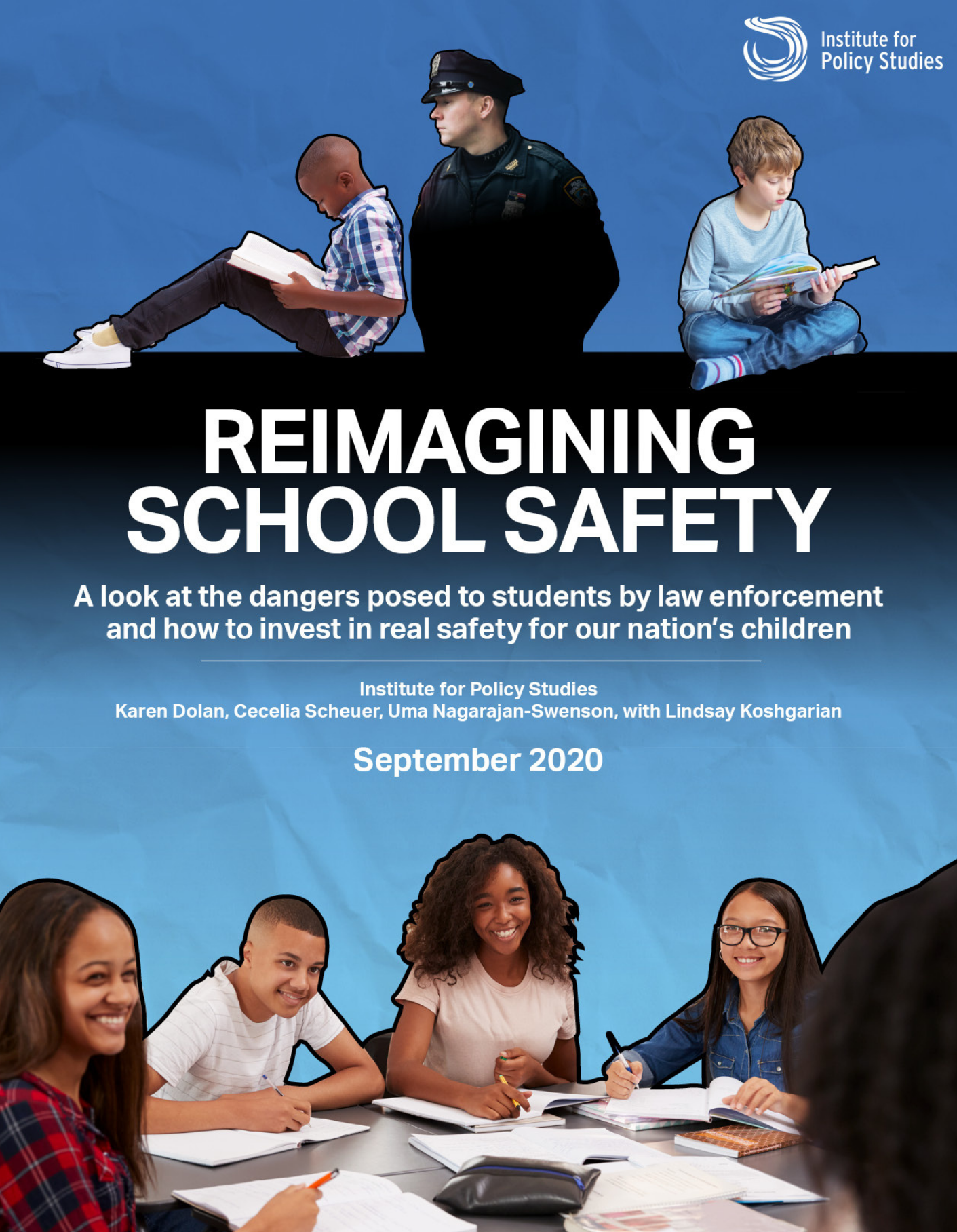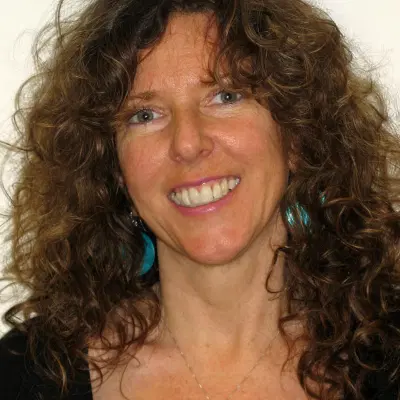Reimagining School Safety
A look at the dangers posed to students by law enforcement and how to invest in real safety for our nation’s children
Karen Dolan | Cecelia Scheuer | Uma Nagarajan-Swenson | Lindsay Koshgarian
Special thanks to Ashik Siddique and Samantha Garcia
Edited by Karen Dolan
Introduction
As the movement for racial justice forces a reckoning on police brutality, school districts across the country are reconsidering the place of police in our schools.
Following the 2018 school shooting in Parkland, Florida, many school districts rushed to hire more armed police officers for their schools. But a large body of research shows that the presence of these armed officers, who can both arrest and use force against students, has had a devastating impact on vulnerable student populations — especially low-income students, Black and brown students, LGBTQ+ students, and students with disabilities.
Thanks to a national movement for racial justice, many school districts are now reconsidering that approach. Cities such as Minneapolis, Portland, Denver, Oakland, and Madison have voted or proposed resolutions to terminate their relationship with local police departments as calls to defund the police gain momentum across the country.
With the COVID-19 pandemic constraining public school budgets, more districts will soon have to choose between funding police officers or counseling programs that have been shown to improve student outcomes.
This report explores the consequences of increased spending on school resource officers since our 2018 report “Students Under Siege” and argues that states should proceed to move cops out of schools entirely. We also present new original findings on the trade-offs that can benefit students by moving money away from policing and toward critical social, emotional and academic supports in our schools.

Key Findings & Observations
- Since 2018, states have allocated an additional $965 million to law enforcement in schools.
- According to a 2019 ACLU study, 1.7 million students have cops in their schools, but no counselors; 3 million have cops, but no nurses; 6 million have cops, but no school psychologists; and 10 million have cops, but no social workers.
- As of 2020, nearly 60 percent of all schools and 90 percent of high schools now have a law enforcement officer at least part time.
- The $33.2 million “school security” budget allocated for 2021 in Washington, D.C., could instead fund up to 222 psychologists, 345 guidance counselors, or 332 social workers.
- The $15 million “school security” budget approved for 2021 in Chicago could instead fund up to 140 psychologists, 182 guidance counselors, or 192 social workers.*
- The $32.5 million “school security” budget allocated for 2021 in Philadelphia could instead fund up to 278 psychologists, 355 guidance counselors, or 467 social workers.

As of 2019, there were nearly 50,000 school resource officers patrolling the hallways of America’s schools. In schools that serve predominantly Black student populations, it is often much more than hallways that are patrolled.
For example, D.C. police are deployed to nearly all high schools to monitor cafeterias, auditoriums, hallways, stairwells, restrooms, entrances, and exits, as well as provide security for school-sponsored events. Such schools promote a learning environment that is more akin to that of a correctional institution than an educational one.
Juvenile policing in schools disproportionately affects students of color.
In 2017, Black and Latinx students made up 40 percent of the U.S. school population, while making up 58 percent of school arrests. Nationwide, Black students are 4 times more likely to be suspended than white students and 3.5 times more likely to be arrested within school than white students, despite exhibiting similar behavioral patterns.
Students of color are also more likely to suffer from disinvestment in their mental health. Black students are three times more likely than non-Black students to attend a school with more security staff than mental health personnel.

The targeted policing of Black, brown, disabled, and LGBTQ+ students creates widespread mistrust between students and law enforcement, resulting in an increase of student offenses and long-term impacts on student success. Students arrested at school are much likelier to experience incarceration as adults.
The disproportionate policing of children of color affects youth outside of school environments as well.
As of October 2015, Black youth were over five times more likely to be detained or committed to the carceral system than white youth. Native American youth were over three times more likely, and Hispanic youth were 61 percent more likely.
Yet researchers have found few differences between Black and white youth regarding common areas of arrest for juveniles: They are roughly as likely to get into fights, carry weapons, steal property, use or sell illicit substances, and skip school.
The safety and well-being of students has been ill-served by punitive discipline.
Fortunately, several school districts have begun to experiment with alternative models of conflict resolution, such as restorative justice circles, that have been shown to foster safer environments and positive outcomes for students, especially for Black, Latinx, LGBTQ+, and disabled youth.
Our 2018 report “Students Under Siege” defines restorative justice practices as those that seek to repair harm by involving all stakeholders in the resolution, rather than punishing an offender for breaking a law or a rule.
True health and safety requires that trained mental health professionals, school nurses, and restorative practitioners are adequately available to students — and that the same principles of restorative justice and support are extended outside of schools as well.

How can we move from criminalizing children to supporting them? We can shift resources.
We looked at three large public school districts — Washington D.C., Chicago, and Philadelphia — to see how many counselors and mental health professionals each district could hire if they shifted their funds from policing their students to creating healthier and safer environments through various forms of school counseling.
Washington, D.C.
D.C.’s combined $32 million in police department and school district security spending could have hired an additional 215 school psychologists, 335 guidance counselors, or 322 social workers.
While new investments in mental health have increased the staffing of counselors and psychologists in the intervening years, based on publicly reported 2015 staffing levels this would represent more than double the school psychologists, a nearly fourfold increase in counselors, or a nearly threefold increase in social workers.
In this summer’s debates over the role and number of security guards and police officers in city schools, Councilmember David Grosso noted that the ratio of security guards and police officers per student is much higher than those for counselors, psychologists, or social workers.
Chicago
Chicago’s planned $15 million budget for school security in FY 2021 could have hired an additional 140 school psychologists, 182 guidance counselors, or 192 social workers. Compared to the 536 social workers budgeted for 2021, an additional 192 personnel would represent a 35 percent increase.
Philadelphia
Philadelphia’s planned $32.5 million budget for school security in FY 2021 could have hired an additional 278 school psychologists, 355 guidance counselors, or 467 social workers. Those resources would represent a near tripling of school psychologists, an 80 percent increase in counselors, or a 40 to 50 percent increase in counseling and social service positions.
Under the auspices of promoting school safety, the policing of students has fueled a school to prison pipeline in which police officers disproportionately criminalize Black, Latinx, LGBTQ+, and disabled youth.
When a law and order approach to education is upheld through the criminalization of adolescent behavior, students in policed schools may find themselves at greater risk of entanglement with the criminal legal system throughout their lives merely by virtue of attending school.
Instead, school districts should shift funds currently supporting the damaging over-criminalization of students into evidence-based restorative practices and counseling programs, which evidence shows can significantly improve outcomes for safety, health, and academic performance.
Ultimately, removing police from schools is the necessary first step in beginning to reimagine school safety.
